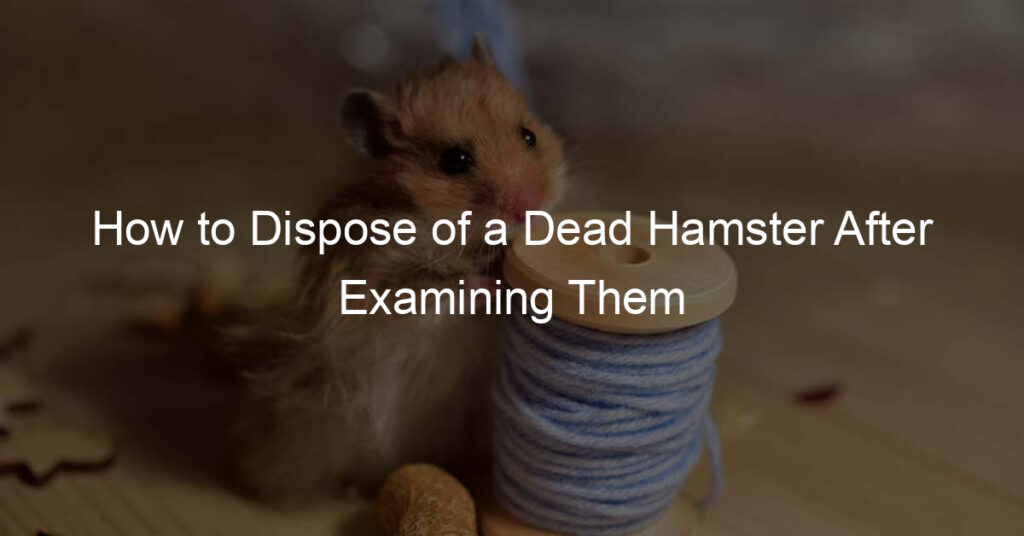Hamsters may make excellent, lovable pets, but they do not live forever. And when the inevitable happens to send your pet off into the afterlife, there are certain precautions you should know.
In this article, you will understand how to know that your hamster is dead and how to deal with it. Keep reading to find out.
How To Determine If Your Hamster Is Deceased

It is normal to experience panic once your hamster dies. Hamsters may die unexpectedly and without notice, leaving many owners asking, “Is my hamster dead?”
Observe the hamster for indications of life before determining how to dispose of the carcass. Some hamsters enter torpor at frigid temperatures.
Although inactivity is uncommon in captivity, hamsters drop their resting metabolic rate and body heat to avoid famine. Torpid hamsters might seem lifeless, although they are still breathing exceptionally slowly.
It is also normal for hamsters to twitch when they die. These nerve spasms are natural, but it may look like the hamster is still living to a person who has never seen them.
When moved, dead hamsters may emit a quick gasp of breath. Sadly, this is not a sign of life; the organs are emptying themselves for the last time.
The bowels are also empty as the muscles relax, a deceptive indication of life. Sadly, this is a reflex that occurs shortly after death.
Therefore, disregard these symptoms and check whether your hamster is still alive by checking the following:
How to Check if the Hamster Is Alive

- Breathing: The body must move up and down even if these motions are weak or sluggish. Additionally, a mirror is placed close to the nose to look for condensation.
- Heartbeat: Two fingers should be placed on the chest to detect a pulse.
- Eyes: If the hamster’s eyes are open, unresponsive, and have substantial black pupils, it has died.
Once you are confident that your hamster is no longer displaying signs of life, you must determine how to dispose of the corpse.
How to Handle a Dead Hamster
Disposing of a dead Hamster after being confirmed to be deceased is crucial. If your Hamster passed away while in the care of a veterinarian, they might ask you to tend to its remains; you should comply with this request.
A vet must organize a burial or cremation safely and legally. It will need an investment of money, time, and effort. However, this expense will be lower than the fine for improper animal disposal.
When your Hamster dies at home, you may choose between the following options:
Private burial: Most individuals lay their deceased pets in a cemetery at their house. There will be legal obligations that are verified.
Cremation: You may organize a private cremation with a local service provider. Even though it will be costly, it will be secure and more prestigious.
Composting: When you choose not to preserve the remnants of your hamster but do not wish to discard them entirely, you may compost them.
Garbage Disposal: You may consult with the local trash collector on the laws and regulations in your area.
Note: If you do not know what to do, you could contact animal control. They would be able to provide ideas based on the circumstances.
Where Should I Keep My Hamster Before Burying Him?
If you are not immediately planning to bury your pet’s body, you should consider cremation. The ideal way to preserve your little pet’s corpse is in an excellent, dry location.
Maintain the temperature as low as possible. Preferably the deceased corpse is maintained at 4 ° C. Or, you may retain the body’s temperature lower than this or even below 0 ° C.
If you preserve the corpse at 0 °, you can preserve the corpse for an almost limitless duration. You have several days to make up your choice for the finest burial possibilities if you keep it at 4 ° C.
What Should I Do if I Am Unable to Bury My Hamster?
If you choose not to bury your hamster, cremation is viable. Immediately after the pet hamster dies away, contact your veterinarian or the local pet cemetery for assistance with cremation.
Will a Hamster’s Corpse Be Rigid?
If your hamster is stiff and inactive, it may have passed away despite a warm temperature. You should contact your veterinarian if you are worried about your pet’s well-being.
Final Thoughts
It is always tough to say farewell to a friend. When the moment arrives to determine how to dispose of your hamster’s corpse, burial or cremation are the most considerate alternatives.
How you conduct any of these actions is up to you. Give yourself the time you need to mourn and be mindful of the symptoms that your hamster is reaching its end of life. You can make them as comfy as possible, mainly if you must make difficult choices.








